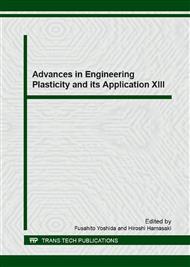p.495
p.502
p.511
p.517
p.523
p.529
p.537
p.542
p.548
An Adaptive Triangle Mesh Generation for One Step Inverse Analysis
Abstract:
One step inverse analysis is widely used in sheet metal forming process, since its effective prediction in a short time. A non-linear equation about unknown displacements from final part to plane part is deduced in one step inverse analysis, and it is often solved by Newton-Raphson method. The initial value of the displacements is quite essential to convergence of Newton-Raphson method. An adaptive triangle mesh on 3D surface equipped with metric frame using advancing front method is presented in this paper to improve condition number of matrix and enhance the convergence rate. Numerical results are showed that one step inverse analysis has faster convergence when the initial displacement is solved by adaptive triangle mesh compared with the part mesh (more triangles on final part), and one step inverse analysis has a well distribution of thickness when initial displacement is solved by adaptive triangle mesh compared with tool mesh (bad-quality triangles on final part).
Info:
Periodical:
Pages:
523-528
Citation:
Online since:
December 2016
Authors:
Price:
Сopyright:
© 2017 Trans Tech Publications Ltd. All Rights Reserved
Share:
Citation:


